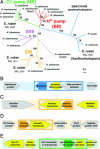The genome of Salinibacter ruber: convergence and gene exchange among hyperhalophilic bacteria and archaea
- PMID: 16330755
- PMCID: PMC1312414
- DOI: 10.1073/pnas.0509073102
The genome of Salinibacter ruber: convergence and gene exchange among hyperhalophilic bacteria and archaea
Abstract
Saturated thalassic brines are among the most physically demanding habitats on Earth: few microbes survive in them. Salinibacter ruber is among these organisms and has been found repeatedly in significant numbers in climax saltern crystallizer communities. The phenotype of this bacterium is remarkably similar to that of the hyperhalophilic Archaea (Haloarchaea). The genome sequence suggests that this resemblance has arisen through convergence at the physiological level (different genes producing similar overall phenotype) and the molecular level (independent mutations yielding similar sequences or structures). Several genes and gene clusters also derive by lateral transfer from (or may have been laterally transferred to) haloarchaea. S. ruber encodes four rhodopsins. One resembles bacterial proteorhodopsins and three are of the haloarchaeal type, previously uncharacterized in a bacterial genome. The impact of these modular adaptive elements on the cell biology and ecology of S. ruber is substantial, affecting salt adaptation, bioenergetics, and photobiology.
Figures




References
-
- Anton, J., Oren, A., Benlloch, S., Rodriguez-Valera, F., Amann, R. & Rossello-Mora, R. (2002) Int. J. Syst. Evol. Microbiol. 52, 485-491. - PubMed
-
- Oren, A., Heldal, M., Norland, S. & Galinski, E. A. (2002) Extremophiles 6, 491-498. - PubMed
-
- Oren, A. & Mana, L. (2002) Extremophiles 6, 217-223. - PubMed
-
- Sher, J., Elevi, R., Mana, L. & Oren, A. (2004) FEMS Microbiol. Lett. 232, 211-215. - PubMed
Publication types
MeSH terms
Substances
LinkOut - more resources
Full Text Sources
Other Literature Sources
Molecular Biology Databases

